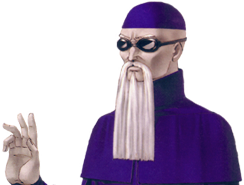Shin Megami Tensei: Nocturne
真・女神転生lll-NOCTURNE マニアクス (Maniax)
Japanese Release: January 29, 2004
Japanese Release of Original Version: February 20, 2003
Retail Price: ¥6,090
US Release: October 12, 2004
Retail Price: $49.99
European/Australian Release: July 1, 2005
Retail Prices: £29.99;
€45; $79.97 AUD
Shin Megami Tensei III: Nocturne for the Playstation 2 was originally released to Japanese audiences on February 20th, 2003 in both a standard and deluxe version (which went for ¥12,800 and included some bonus items). It was the first true addition to the main series since the original Super Famicom release of Shin Megami Tensei II on March 18th, 1994. As such, one can understand the magnitude of releasing a full-on sequel for a series almost ten years later. SMTIII: Nocturne was highly anticipated and met with good sales upon its release.
Around this time, fans noted that Atlus USA, Inc. was oddly quiet about the title. Nothing was announced about the game's release and it was assumed the title was simply being passed over for other, smaller (and logically, easier to localize) titles. Time came and went.
Atlus Co, Ltd. eventually announced a second version of SMTIII: Nocturne; a "Director's Cut" of sorts. It would be referered to as the "Maniax" version and feature a slew of new additions and adjustments. These included such things as:
- General game balance adjustments (lowered ambush attacks, lower instant death rates, etc.)
- Selectable difficulty level from the on-set (Normal or Hard)
- The addition of the Labyrinth of Amala and, hence, the addition of the Fiends
- A new "true demon" ending
- Pierce was added as a new skill
- A new opening movie
The addition that gained the most attention, however, was Dante of Capcom's Devil May Cry series. The story goes that the developers enjoyed the game and character enough to add him into the "Maniax" version, initially without Capcom's approval. Upon showing the game to Capcom, they liked what Atlus had done and approved of the use of Dante. Dante acts as more than a simple cameo, although at the same time he isn't given a full-on treatment that rivals other main characters in the title. He is, however, a nice addition to the story, well utilized and true to his existing personality. Since the release of the title, Atlus's Kazuma Kaneko became the designer of Dante's new demonic form in the critically acclaimed Devil May Cry 3.
Atlus USA, Inc. remained silent on this version for quite some time as well. However, they finally announced plans to release the "Maniax" version of the title in the United States. Due to the fact that none of the titles had been released here before the number was removed from the title and the game was released as simply Shin Megami Tensei: Nocturne, dropping both the "III" and "Maniax" from the title.
Finally confirming rumors, European and Australian audiences got their first shot at the game on July 1st, 2005. It was released under an agreement between Atlus, Ghostlight Interactive and Ubisoft. In order to be accessible, the game has a new selectable language option. Unfortunately, some players have reported that the translation into other languages is not at the same quality standards the English translation had set.
As far as the game itself goes, Shin Megami Tensei III: Nocturne was the first time the main series attempted a third-person viewpoint while within the dungeons. The ones that preceded it all utilized first-person dungeon segments. The overhead map view makes a return, although this time around it is far more detailed.
Battles have also been adjusted and are far more streamlined. Nocturne marks the first appearance of the Press Turn battle system, which was also utilized within Digital Devil Saga. Rather than the simple "hit or miss" system of most RPGs (including the first two Shin Megami Tensei titles), the game rewards or punishes you for good or poor actions in battles. Your team has one Press Turn icon per character and any action uses one of these. Taking advantage of an enemy's weakness or getting in an especially strong hit uses half of a Press Turn icon instead of a full one. This half icon can be used as though it was a full icon, effectively lengthening your attack time. However, if you miss or the character is strong to your attack an additional Press Turn icon will be wasted. This will be multiplied by how many characters the spell or attack affects, which means a single bad choice can waste your entire turn.
As far as influences, Nocturne, much like the ones preceding it, most heavily focuses on an altered Judeo-Christian belief style and a single main Creator God. However, like the games before it, lesser gods and demons of various other mythologies do make appearances of varying importance. The story itself focuses on the destruction of the world and its subsequent rebuilding. The protagonist's decisions along the course of the game affect the world's path and outcome. This dynamic required the existance of a few completely different endings, all of which are reached by taking different paths in the game.
© Tony
Archives
One Response to “Shin Megami Tensei: Nocturne”
Leave a Reply
You must be logged in to post a comment.





八月 29th, 2010 at 12:56 上午
I played Nocturne at my friend’s house and I must say that the storyline is VERY interesting. I had to go home after a bit but the small bit of intro played at my friend’s house is making me consider actually buying the game for myself =)